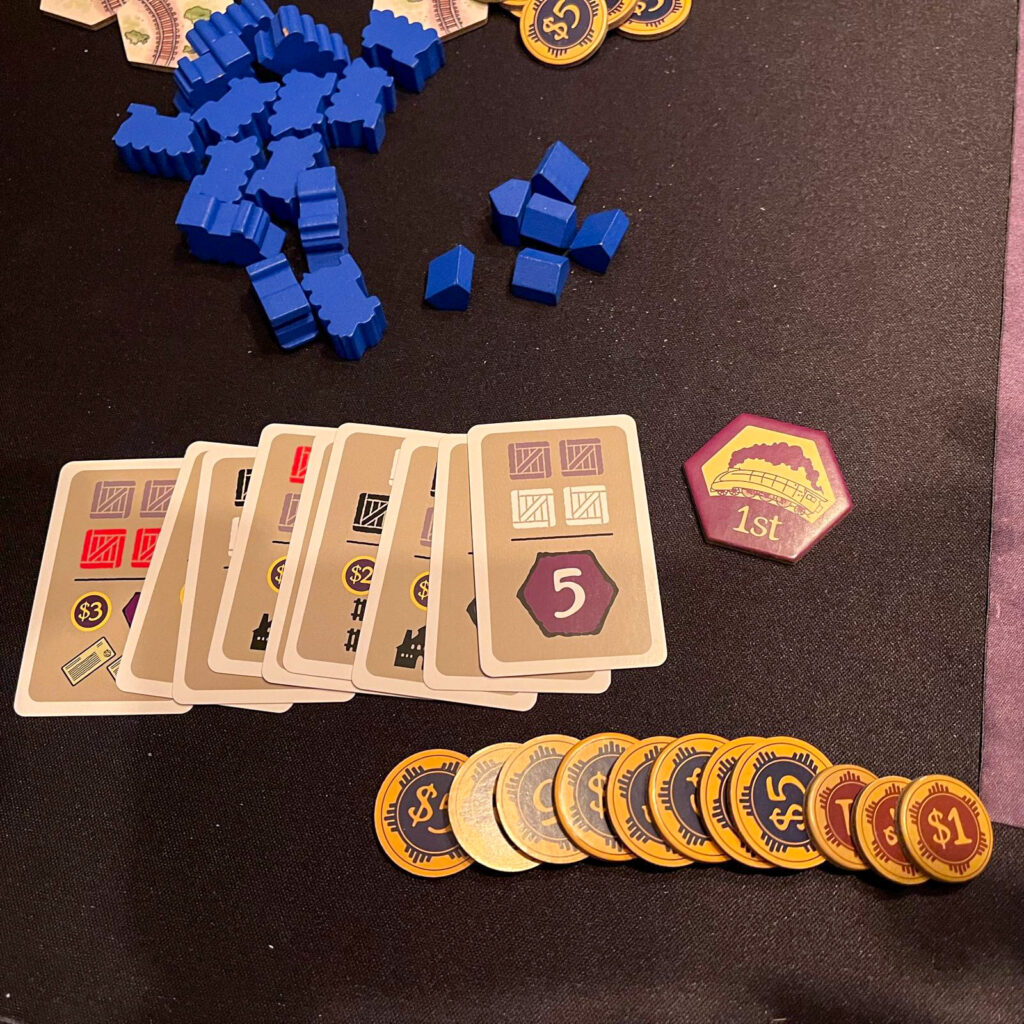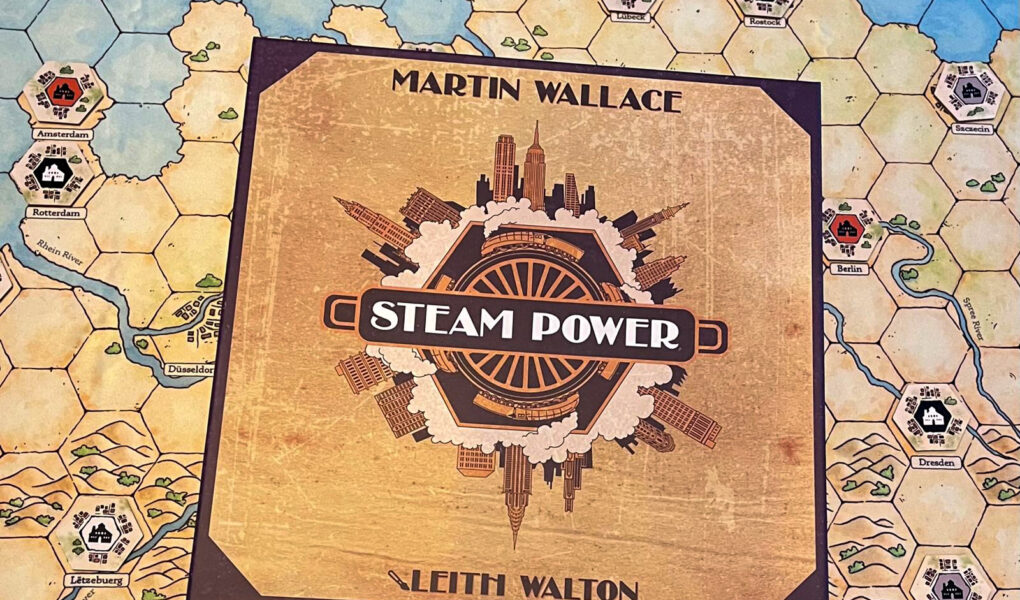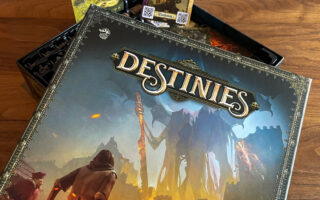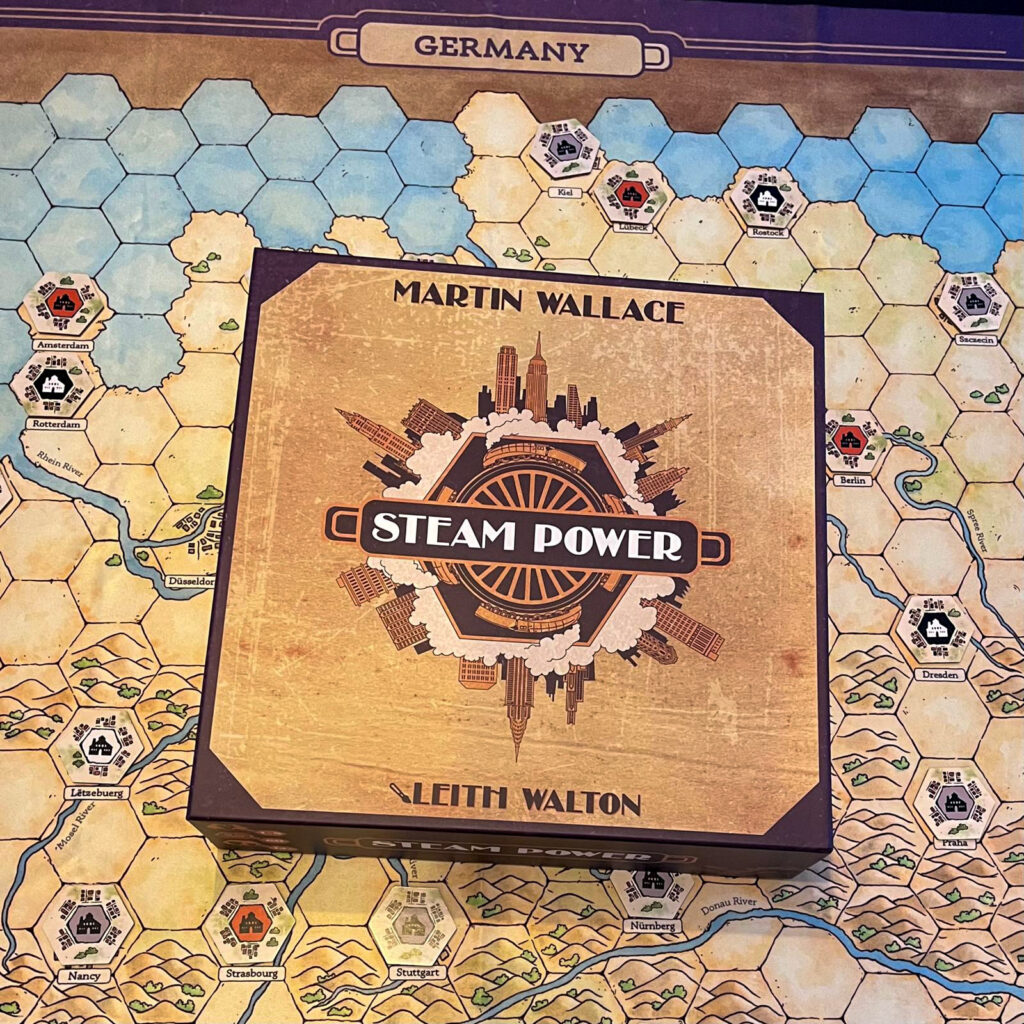
Summary
A game for 1 – 5 players
Playing time is 45 – 90 minutes
Publisher is Wallace Designs
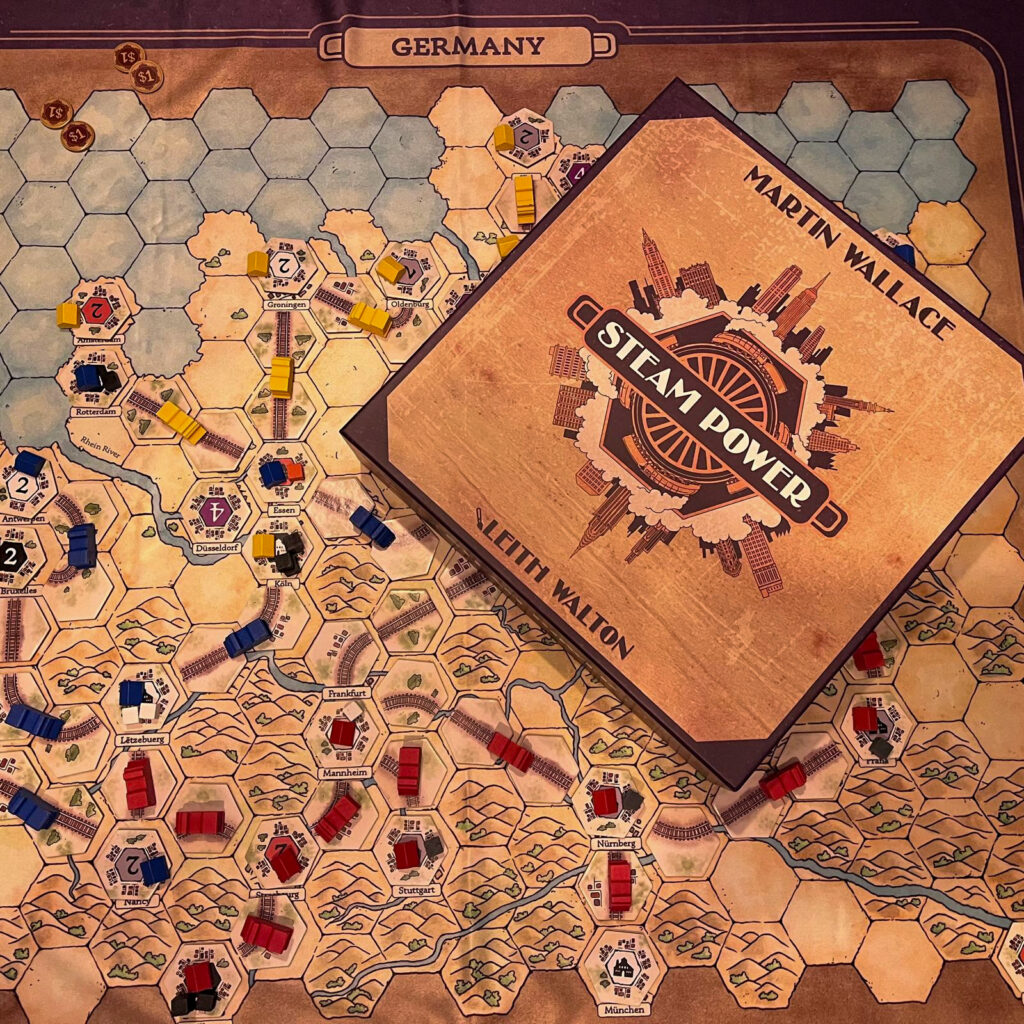
Introduction
In Steam Power, players take on the role of train company owners, competing with others to become the best.
While laying tracks, connecting more and more cities to your network. Players will build factories that produce resources. Those resources are then moved around the map over completed rail links to fulfill contracts, earning you points and other bonuses.
It is allowed, and usually necessary, to use resources from the factories of other players and to transport those resources over rail links belonging to other players. Doing so requires you to pay those other players for their services.
The game ends when a player has fulfilled a certain number of contracts. Victory Points are then added up from fulfilled contracts, connections to certain cities, factories, and remaining money. The player with the most Victory Points wins the game.
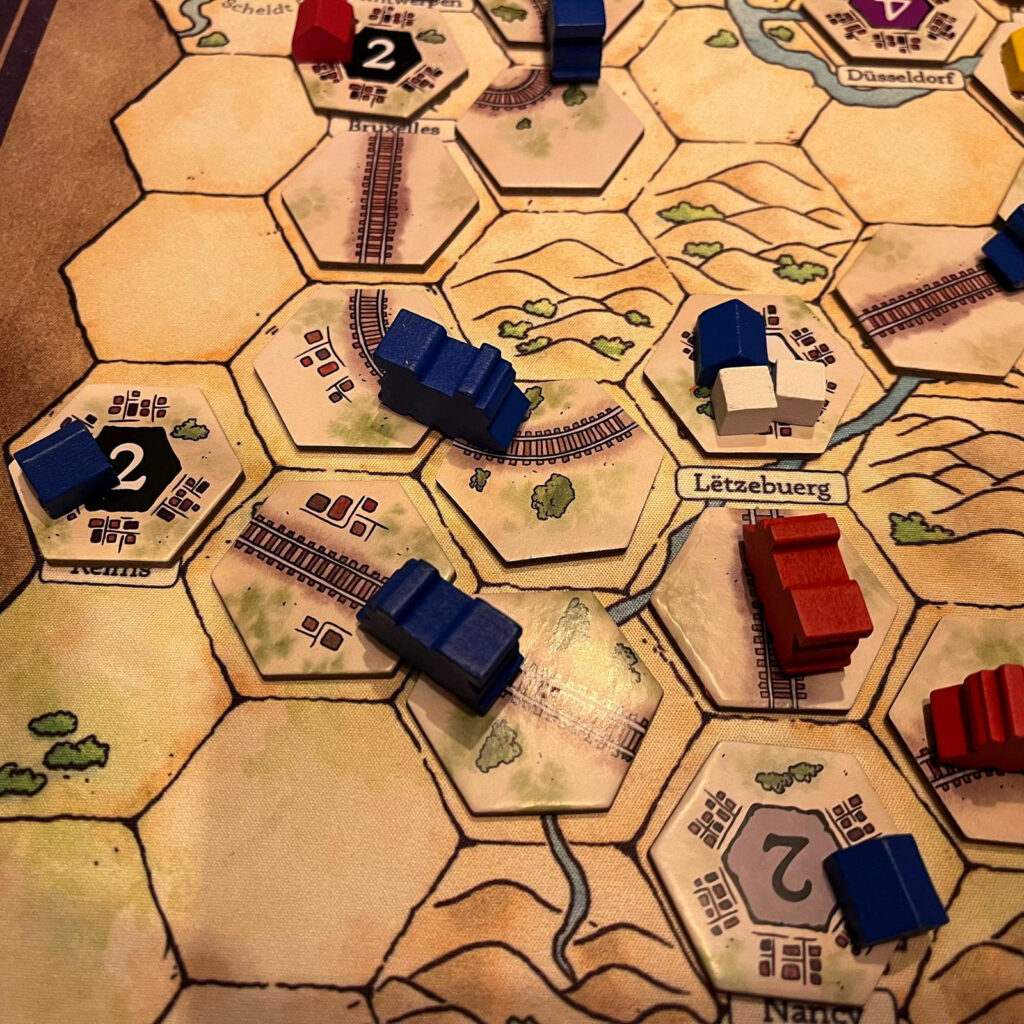
Setting up the game
Start by choosing which map the game will take place on and place it in the middle of the table.
All city tiles can be mixed up in the bag; then, one by one, draw a city tile and place it on an empty city hex of the map.
These city tiles have two different types:
– Factory tiles, with a factory indicated on one side and VP on the other side. The tiles also have different colors, which relate to the different resources.
– VP tiles, which have only VP indicated on both sides of the tile. Besides this, these tiles are purple in color.
After filling all the city hexes on the map, it’s possible to have some city tiles remaining. These can be placed beside the map and are relevant during the final scoring.
Then, separate the track tiles and place them beside the map.
Also, repeat this for the resources and the money.
Each player will choose a color and take the corresponding trains and factories.
Shuffle the contract tiles, and each player will draw five.
Additionally, the players start with $5 and determine who will be the first player.
Quick and easy, now everybody is ready to lay those tracks and begin the game.

Let’s play
To start with the end, the final game is triggered by how many contracts are fulfilled. This is related to how many players are in the game.
So, in each round, all players have to perform two actions. There are a total of five actions available:
– Lay tracks: Here, players can take a total of two track tiles and place them on the map. Some terrains will cost money, like Hills and Mountains, but the Plains are free. These tiles do need to be placed on the map, starting from a city tile. It’s possible to finish a track between cities in several turns, which is called a complete link. However, it can’t be started or finished by different players. All unfinished links need to be completed by the player who started the track.
– Build a Factory: To perform this action, a city on the map needs to be connected by a completed link. The player who places the factory does not need to be the one who has the completed link to this city, as long as the player has a link to that city. When the factory is placed, related to the color of that tile, the corresponding resources will be placed on this tile. The quantity of the resources is related to the player count. The VP tiles, which are purple in color, will not be used in this action and can’t be built on.
-Fulfill Contract: Each contract will require a certain amount of resources needed to be fulfilled. These resources can be retrieved from all factories that are connected by completed links. Using resources and completed links from other players isn’t free.
Using a resource from another player’s factory will cost $1 each. Then, for transport using completed links from other players, it will cost $1 for each completed link used.
When a contract has been completed, money, bonus actions, and VP can be earned. Money and/or bonus actions will be awarded immediately. The VP will be counted at the end of the game.
If a factory runs out of resources, this tile will be flipped to the VP side, so the owner of this factory will count them at the end of the game.
When resources aren’t available anymore, they can be purchased for an amount of $5.
– Take Contracts: This action allows players to draw two new contracts. There is no limit on the number of contracts a player can have. If no more are available, then a player can draw from other players who still have unfulfilled contracts, starting with the player who has the most contracts.
– Take money from the bank: perform this action and take $3 from the bank/general supply.
When a player has fulfilled the necessary contracts related to the player count, the end game is triggered.
After everyone has finished, players start calculating their VPs:
– Each $5 is worth 1 VP.
– All VPs achieved from the fulfilled contracts.
– Each flipped factory tile.
– Each VP tile of a player that has a complete link to these purple tiles. Depending on how many players have a complete link to a purple tile, the VPs will be adjusted. If there are purple tiles beside the map, this will also grant end VPs.
After everything has been added and counted, the player with the most VPs will be the winner of Steam Power.
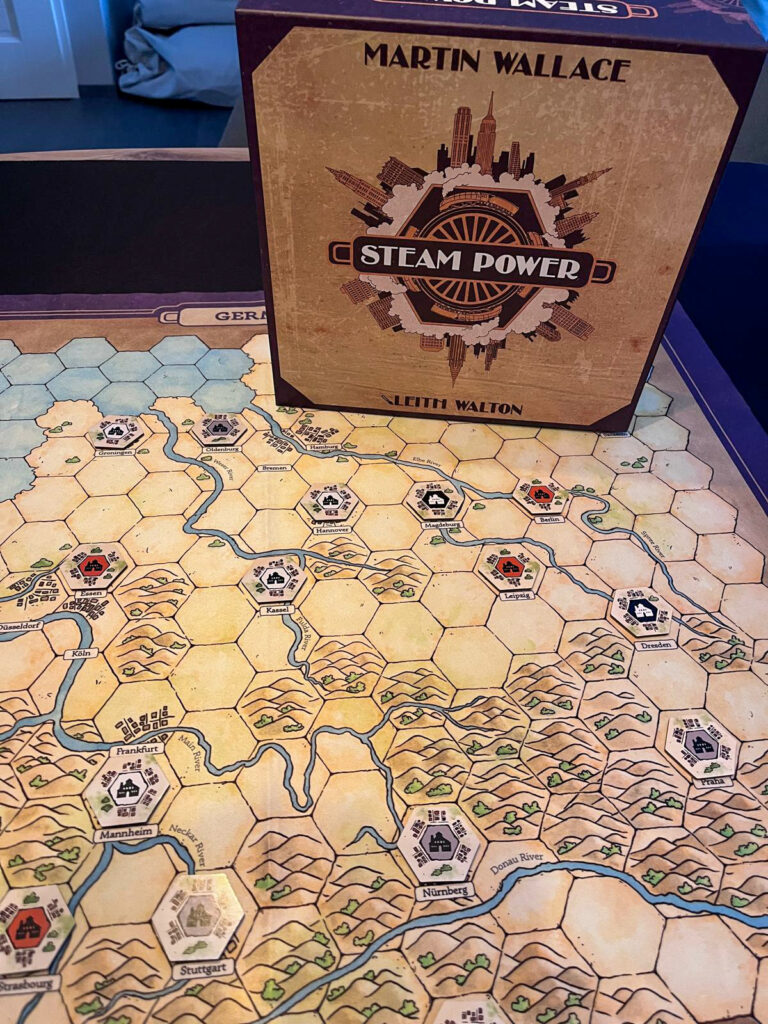
Conclusion & final score
Difficulty: 2.00/ 5
Re-playability: 7
Our score: 7 out of 10 dice
We received a preview of the retail copy with the standard components. These were already nicely produced. The thickness of the carton is of good quality, which gives the game a good start. An inlay would be an added value to make it even better to set this up.
I was very surprised by the choice of material used for the maps. It is a really good option when laying the track tiles. They stay flat on the table and are easy to handle.
During the play, I got a nice balanced feeling of playing a game that is a blend of Ticket to Ride and an 18xx game. It offers an easy and relatively low barrier to entry for track building and economic gameplay, which would normally be either too easy or too difficult to get onto the table during a family evening.
In the retail version, there are two maps, which is good. However, I would recommend adding the other maps available in the Deluxe version. This will enhance the replayability experience even further. Additionally, the rulebook we received seemed more focused on the Deluxe version than the retail one. Also, the resources aren’t that easy to manage when compared to the Deluxe version.
Furthermore, when sourcing your resources for filling a contract, it can get a bit tricky with many players and determining who to pay what. It also makes it fun with three or more players, although it can become a bit unclear when the final counting needs to be completed.
But truly, it is a very nice family game that has a variety of ways to play, either solo or with some automa players, which is nicely indicated in the rulebook with several options.
Thanks to Wallace Designsfor this review copy and the opportunity to write about it.
